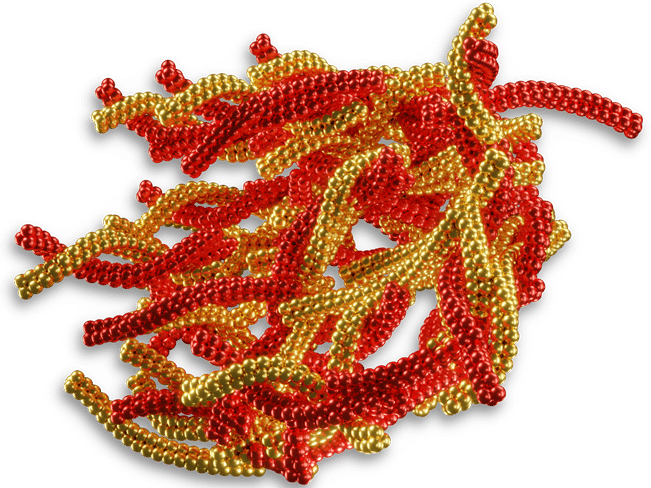Ultra-long protein fibrils give clues on dementia risk
"AFM technology has the potential to complement conventional biomarker tests and improve the early detection of Alzheimer's"
During the course of Alzheimer's disease, protein fibrils appear in the spinal fluid of affected individuals. Empa researchers, together with the Department of Neurology at the Cantonal Hospital in St. Gallen, have now visualized the wide spectrum of protein aggregates from oligomers, protofibrils to fibrils in the spinal fluid. The conclusion: Ultra-long protein fibrils are a signature of severe Alzheimer’s disease. The study, recently published in Communications Biology, sheds light into the delicate role of protein aggregation in the development of Alzheimer's disease and is expected to improve early detection of dementia.

In Alzheimer's disease, protein fibrils in the brain form plaques. The accumulation of such tangles leads to the death of nerve cells and a loss of cognitive performance.
Illustration: Empa / Communications Biology
The early detection and treatment of dementia such as Alzheimer's is still one of the great challenges of modern medicine. It is already known that certain proteins in the cerebrospinal fluid can be used to diagnose Alzheimer's disease. However, the current detection methods for such biomarkers by means of biochemical tests can only confirm and quantify the presence of such pathological proteins. No conclusions can be drawn about their original morphology of the proteins using biochemical assays, which holds information on disease stages.
However, such information if obtained directly in a label-free manner could allow conclusions to be drawn about the stage of the disease and evaluate the efficiency of a prescribed treatment. A team from the Transport at Nanoscale Interfaces Laboratory at Empa and the Department of Neurology at the Cantonal Hospital in St. Gallen has now used atomic force microscopy (AFM) to visualize the proteins that are indicative of Alzheimer's disease under conditions that are as close to reality as possible. The researchers recently published their results in the journal Communications Biology.
Molecule in natural shape
With the new study, the researchers add another piece of the puzzle to their insights into Alzheimer's development and diagnosis. In an earlier study, the team led by Empa researcher Peter Nirmalraj from the Transport at Nanoscale Interfaces laboratory in Dübendorf had already been able to reveal potentially pathological proteins in their natural form in blood. For their work, they received recognition from the Franco Regli Foundation for neurodegenerative disease research in Bern. Now the researchers are showing in detail the unaltered shape of the proteins directly in the spinal fluid.
Impressive precision
This was possible thanks to a technology that makes the world of molecules visible in their innermost parts with impressive precision: atomic force microscopy (AFM). Reminiscent in size of a conventional table-top microscope, AFM technology enables morphological observations in the nanometer range without destroying the proteins. And in analyzing the differences in size, structure, shape and assembly patterns of protein accumulations directly in spinal fluid, the team has now been able to identify a link to disease stage. "While only short protein fibrils, about 100 nanometers in length, were found in people at an early stage of the disease, fibrils with multiples of this length – reaching several micrometers – appeared in later stages of the disease," says biophysicist Nirmalraj. In cognitively healthy individuals, on the other hand, no or even shorter fibrils were present in the spinal fluid samples.
Tailwind for AFM technology
After these pilot studies with 33 people, the team will now step up efforts to match the findings collected in the lab with data from larger groups of patients and obtain information on the chemical nature of the proteins in body fluids. Recently, Nirmalraj received support from the Dementia Research Synapsis Foundation Switzerland, to further advance the on-going study for early blood-based detection of Alzheimer’s disease.
"AFM technology has the potential to complement conventional biomarker tests and improve the early detection of Alzheimer's," Nirmalraj is convinced. This is because while biomarker tests indicate protein levels, AFM technology can provide information on the morphological differences in protein aggregates, which reflects the progression of the disease, he said. In addition, it will be possible to further fathom the disease process in order to provide the basis for new, more effective drugs.
Original publication
PN Nirmalraj, T Schneider, L Lüder & A Felbecker; Protein fibril length in cerebrospinal fluid is increased in Alzheimer’s disease; Communications Biology (2023).
PN Nirmalraj, T Schneider, A Felbecker; Spatial organization of protein aggregates on red blood cells as physical biomarkers of Alzheimer’s disease pathology; Science Advances (2021).






















































